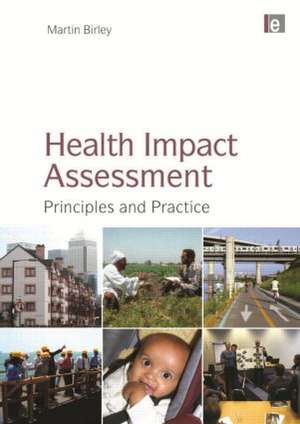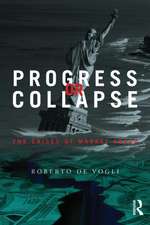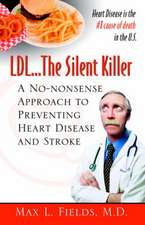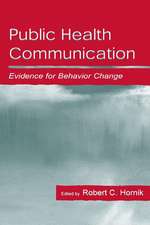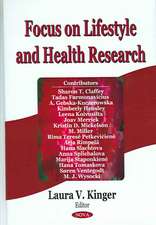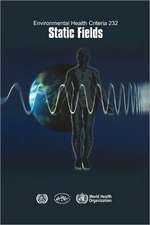Health Impact Assessment: Principles and Practice
Autor Martin Birleyen Limba Engleză Hardback – 6 iul 2011
The purpose of this book is to fill this gap and to introduce the subject of Health Impact Assessment using plain language, in both general and specific contexts and with reference to both market and less developed economies. As a result, the reader should be able to describe what HIA can and cannot achieve, identify the components of a successful HIA and participate in an assessment as a member of a team. Examples are provided from a number of planning and development sectors, including extractive industry, water resource management, and housing. The reader, whether student or professional, need not be a health specialist, although prior knowledge of some public or environmental health would be an advantage.
| Toate formatele și edițiile | Preț | Express |
|---|---|---|
| Paperback (1) | 351.71 lei 6-8 săpt. | |
| Taylor & Francis – 5 iul 2011 | 351.71 lei 6-8 săpt. | |
| Hardback (1) | 872.98 lei 6-8 săpt. | |
| Taylor & Francis – 6 iul 2011 | 872.98 lei 6-8 săpt. |
Preț: 872.98 lei
Preț vechi: 1176.63 lei
-26% Nou
Puncte Express: 1309
Preț estimativ în valută:
167.10€ • 181.57$ • 140.45£
167.10€ • 181.57$ • 140.45£
Carte tipărită la comandă
Livrare economică 21 aprilie-05 mai
Preluare comenzi: 021 569.72.76
Specificații
ISBN-13: 9781849712767
ISBN-10: 184971276X
Pagini: 400
Dimensiuni: 174 x 246 x 24 mm
Greutate: 0.31 kg
Ediția:New.
Editura: Taylor & Francis
Colecția Routledge
Locul publicării:Oxford, United Kingdom
ISBN-10: 184971276X
Pagini: 400
Dimensiuni: 174 x 246 x 24 mm
Greutate: 0.31 kg
Ediția:New.
Editura: Taylor & Francis
Colecția Routledge
Locul publicării:Oxford, United Kingdom
Public țintă
Academic and Professional Practice & DevelopmentCuprins
Foreword. 1. Introduction. 2. Health and its Determinants. 3. History of HIA. 4. HIA Management. 5. Methods and Tools. 6. Baseline Report. 7. Prioritization. 8. Recommendations and Management Plan. 9. Water Resource Development. 10. Extractive Industries. 11. Housing and Spatial Planning. 12. Current and Future Challenges. 13. Sources of Further Information. 14. Glossary and Acronyms.
Notă biografică
Martin Birley is an independent international consultant in Health Impact Assessment, former Senior Lecturer at the University of Liverpool, UK, and former Senior Health Advisor on HIA at Shell.
Recenzii
Health Impact Assessment came Highly Commended in the Public Health category for the 2012 BMA Medical Book and Patient Information Awards.
'A comprehensive description and discussion of an important area of public health where there are few/no alternative texts. The quality of the arguments is very high. This is a key text in an undersupplied and important area for public health practice' – British Medical Association
'To many people, Health Impact Assessment is a new concept requiring new skills. A pioneer and global expert in the subject, Dr Birley has been grappling successfully with this challenge for many decades. His book reveals extraordinary experience and insight, providing depth and context to existing HIA guidelines, invaluable to those who are trying to use them.' Professor Sir Michael Marmot, professor of Epidemiology and Public Health, University College London, Chair Commission on Social Determinants of Health and the Strategic Review of Health Inequalities in England post 2010 (Marmot Review) and current president of the BMA
'I warmly commend this book. Apart from being by far the most useful work on how to operationalize Health Impact Assessment, the book is brilliantly comprehensive and a profoundly wise distillation of the author's unparalleled experience worldwide.' Robert Goodland, former Senior Environmental Advisor to the World Bank Group in Washington, DC, and former president of the International Association for Impact Assessment
'This is a very comprehensive overview of Health Impact Assessment from a UK and international perspective and will be most useful for both beginners and experienced practitioners. The structure makes it easy to use as a reference book and the wealth of examples bring it to life. It is an excellent contribution to ensuring that HIA continues to develop as an internationally recognised and valued methodology for assessing new developments for their impact on people's lives and the environment we live in.' Colleen Williams, former HIA Policy lead at Department of Health, London
'This is an excellent handbook on international HIA by one of the pioneers of HIA theory and practice. It has something for new and experienced HIA practitioners alike. The case study examples, his tips on how to avoid common pitfalls and his insights into how to enhance the value of a HIA are outstanding. This is a must-have book that should be on the desk of anyone who undertakes, commissions or teaches HIA in both developed and, especially, developing countries.' Salim Vohra, Director, Centre for Health Impact Assessment, Institute of Occupational Medicine, London
'With many practical examples from throughout the world, teamed with thoughtful discussion and considered theory, this book provides a bridge for all people interested in the art and science of impact assessment to further develop their understanding and knowledge.' Robert Quigley, Director, Quigley and Watts Ltd; Co-Director, HIA Research Unit, University of Otago, New Zealand
'Martin Birley was a pioneer of health impact assessment, working first in low income countries and more recently also in the UK. This book is the crystallisation of these years of experience. It is ambitious in scope, being designed primarily as a practical guide for those wanting to do HIA and including detailed explanations of key concepts, approaches and methods, with case studies and exercises. There are chapters on the issues to consider in HIAs of three key sectors - water resource management, extractive industries and housing and spatial planning which will give practitioners insight into specific sectoral issues. My own favourite section is on the history of HIA, which challenged my understanding of how different approaches to HIA developed and the assumptions underpinning these. This book will be invaluable to those already working on HIAs as well as those wanting an introduction to the basic steps.' Margaret Douglas, Consultant in Public Heath, Edinburgh, Scotland
'This book is both a comprehensive text book for those new to HIA and a useful reference text—and very enjoyable read—for HIA practitioners. It sets out the rationale for HIA, stages of an HIA, the methods and evidence used and development of recommendations. The book is well presented and easy to follow: each chapter has a summary of the contents, practical exercises for students and a full bibliography. It also contains many illustrative examples and case studies.' Margaret J. Douglas, Journal of Public Health
'The scope of the book is vast and yet it feels like a conversation... Policies, plans, programmes and projects affect health. They can have wonderful and beneficial effects. They can have awful and unintended adverse effects. This central message is not new to the world of impact assessment, but Birley's focus on health is welcome and its treatment in a book of this kind is long overdue.' – Ben Cave, in Impact Assessment and Project Appraisal (2012).
'A comprehensive description and discussion of an important area of public health where there are few/no alternative texts. The quality of the arguments is very high. This is a key text in an undersupplied and important area for public health practice' – British Medical Association
'To many people, Health Impact Assessment is a new concept requiring new skills. A pioneer and global expert in the subject, Dr Birley has been grappling successfully with this challenge for many decades. His book reveals extraordinary experience and insight, providing depth and context to existing HIA guidelines, invaluable to those who are trying to use them.' Professor Sir Michael Marmot, professor of Epidemiology and Public Health, University College London, Chair Commission on Social Determinants of Health and the Strategic Review of Health Inequalities in England post 2010 (Marmot Review) and current president of the BMA
'I warmly commend this book. Apart from being by far the most useful work on how to operationalize Health Impact Assessment, the book is brilliantly comprehensive and a profoundly wise distillation of the author's unparalleled experience worldwide.' Robert Goodland, former Senior Environmental Advisor to the World Bank Group in Washington, DC, and former president of the International Association for Impact Assessment
'This is a very comprehensive overview of Health Impact Assessment from a UK and international perspective and will be most useful for both beginners and experienced practitioners. The structure makes it easy to use as a reference book and the wealth of examples bring it to life. It is an excellent contribution to ensuring that HIA continues to develop as an internationally recognised and valued methodology for assessing new developments for their impact on people's lives and the environment we live in.' Colleen Williams, former HIA Policy lead at Department of Health, London
'This is an excellent handbook on international HIA by one of the pioneers of HIA theory and practice. It has something for new and experienced HIA practitioners alike. The case study examples, his tips on how to avoid common pitfalls and his insights into how to enhance the value of a HIA are outstanding. This is a must-have book that should be on the desk of anyone who undertakes, commissions or teaches HIA in both developed and, especially, developing countries.' Salim Vohra, Director, Centre for Health Impact Assessment, Institute of Occupational Medicine, London
'With many practical examples from throughout the world, teamed with thoughtful discussion and considered theory, this book provides a bridge for all people interested in the art and science of impact assessment to further develop their understanding and knowledge.' Robert Quigley, Director, Quigley and Watts Ltd; Co-Director, HIA Research Unit, University of Otago, New Zealand
'Martin Birley was a pioneer of health impact assessment, working first in low income countries and more recently also in the UK. This book is the crystallisation of these years of experience. It is ambitious in scope, being designed primarily as a practical guide for those wanting to do HIA and including detailed explanations of key concepts, approaches and methods, with case studies and exercises. There are chapters on the issues to consider in HIAs of three key sectors - water resource management, extractive industries and housing and spatial planning which will give practitioners insight into specific sectoral issues. My own favourite section is on the history of HIA, which challenged my understanding of how different approaches to HIA developed and the assumptions underpinning these. This book will be invaluable to those already working on HIAs as well as those wanting an introduction to the basic steps.' Margaret Douglas, Consultant in Public Heath, Edinburgh, Scotland
'This book is both a comprehensive text book for those new to HIA and a useful reference text—and very enjoyable read—for HIA practitioners. It sets out the rationale for HIA, stages of an HIA, the methods and evidence used and development of recommendations. The book is well presented and easy to follow: each chapter has a summary of the contents, practical exercises for students and a full bibliography. It also contains many illustrative examples and case studies.' Margaret J. Douglas, Journal of Public Health
'The scope of the book is vast and yet it feels like a conversation... Policies, plans, programmes and projects affect health. They can have wonderful and beneficial effects. They can have awful and unintended adverse effects. This central message is not new to the world of impact assessment, but Birley's focus on health is welcome and its treatment in a book of this kind is long overdue.' – Ben Cave, in Impact Assessment and Project Appraisal (2012).
Descriere
Health Impact Assessment (HIA) is primarily concerned with the future consequences of plans, proposals and policies on the health of communities and a complement to Environmental Impact Assessment. The purpose of this book is to introduce the subject using plain language, in both general and specific contexts.
